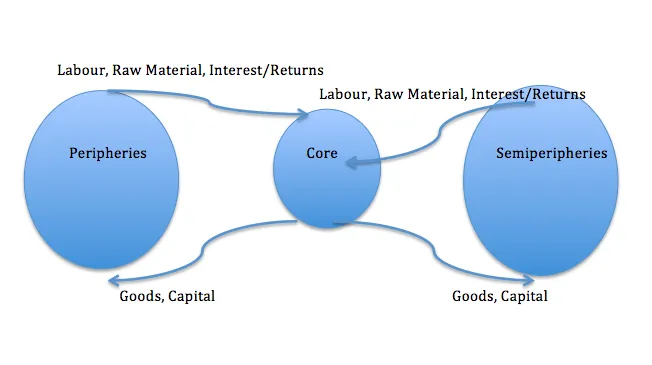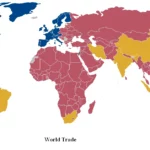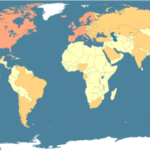Imagine a world map where countries are neatly categorized into three groups: core, semi-periphery, and periphery. The core boasts wealth and power, dictating the terms of global trade, while the semi-periphery occupies a middle ground, and the periphery struggles to keep up. This is the essence of Immanuel Wallerstein’s influential World System Theory. But in a world experiencing rapid transformation, does this model still hold water? This article delves into the intricacies of the modern world-system, examining the relevance of Wallerstein’s categories in the 21st century.
Criticisms of Wallerstein’s World System Theory
Wallerstein’s World System Theory has profoundly impacted our understanding of the global economy. By suggesting a hierarchical division of the world – core, periphery, and semi-periphery – the theory provides a framework for analyzing global inequality. However, it has attracted its share of criticism. Let’s break down some key points of contention:
Beyond Economics:
Critics argue that Wallerstein’s theory might focus too heavily on economics as the sole driver of global inequality. While economic factors are undoubtedly significant, this perspective potentially overlooks the profound influence of culture, politics, and individual choices. Just as understanding a city requires more than analyzing traffic patterns, understanding global inequality necessitates considering a broader range of factors.
Challenging the One-Size-Fits-All Model:
While Wallerstein presented an alternative to modernization theory’s linear view of development, some suggest his model might have swung too far in the opposite direction. By emphasizing nation-states and a singular path for the global economy, the theory may oversimplify the intricate ways countries and regions interact and evolve.
The Quest for Empirical Evidence:
A common criticism centers around the theory’s perceived lack of robust empirical support. Critics argue that Wallerstein’s generalizations, while thought-provoking, require more concrete evidence and testable predictions to solidify their validity.
Unraveling the Origins of Capitalism:
One of the most significant challenges lies in explaining the very genesis of the capitalist world system. The theory doesn’t fully address how this system arose, leaving a crucial gap in our historical understanding. This lack of clarity regarding the system’s origins raises questions about the completeness of the model.
So, is Wallerstein’s Theory Entirely Invalid?
Not necessarily. While these criticisms highlight areas for further investigation, they don’t render the theory entirely obsolete. Wallerstein’s work has sparked essential debates and encouraged scholars to think critically about global inequality. Consider it an initial draft—potentially requiring revisions and refinements—yet providing a valuable foundation for further exploration.
The Takeaway
Our understanding of global economics is continually evolving. New research challenges existing theories and reshapes our perspectives. Wallerstein’s theory, while not without flaws, has played a pivotal role in advancing this conversation. It serves as a reminder that our understanding of complex systems is always a work in progress.
What are the weaknesses of the Wallerstein world system theory?
Wallerstein’s World Systems Theory, while influential, has faced criticism for several perceived weaknesses:
The Limits of Economics:
One primary critique targets the theory’s strong emphasis on economic factors in explaining global inequality. While economic forces are undoubtedly significant, critics argue that the theory downplays the role of culture, local politics, and individual agency in shaping societal development.
Navigating a Complex World:
Another criticism centers on the theory’s categorization of countries into core, periphery, and semi-periphery. While this framework offers a simplified view of global power dynamics, critics argue that the real world is far more nuanced. Countries do not always fit neatly into these categories, and the theory may not adequately account for the dynamic and fluid nature of global interactions.
The Need for Empirical Support:
Some scholars point to a perceived lack of robust empirical evidence to support the theory’s claims. While Wallerstein’s work offers compelling ideas, critics argue that it sometimes lacks rigorous data analysis and testable predictions, which are essential for validating any social science theory.
Addressing the Gaps:
Beyond these critiques, additional concerns remain. For instance, the theory does not fully explain how the capitalist world-system emerged in the first place, leaving a critical gap in our understanding of its historical development. Additionally, its focus on nation-states might lead to overlooking the growing influence of international organizations and multinational corporations in shaping the global landscape.
A Valuable Tool, With Caveats:
Despite these weaknesses, World Systems Theory remains a valuable tool for understanding the global economy. It provides a broad lens for examining interconnectedness and patterns of inequality. However, it is crucial to acknowledge its limitations and consider alternative perspectives for a more complete understanding of our complex world.
What are the criticisms of world system theory?
Wallerstein’s world systems theory, while groundbreaking, has faced scrutiny for its methodology and scope:
Lack of Granularity:
One of the most common criticisms targets the theory’s broad-brush approach. While it effectively highlights large-scale patterns, critics argue that it sometimes lacks the nuance to explain variations in development trajectories. This emphasis on sweeping generalizations, they contend, can overshadow the importance of local contexts, internal dynamics, and historical contingencies in shaping individual countries’ experiences.
The Determinism Debate:
Another point of contention revolves around the theory’s perceived determinism. By presenting a somewhat fixed structure of core, periphery, and semi-periphery, critics argue that it may downplay the potential for agency and change within the system. This rigidity, they contend, could lead to a pessimistic outlook, suggesting that countries on the periphery are locked into their positions.
Beyond Economics:
The theory has also been challenged for its singular focus on economics. While economic factors are undoubtedly central to the world system, critics argue that neglecting the influence of cultural, political, and social forces provides an incomplete picture. Factors like cultural values, political systems, and historical legacies all contribute to a nation’s trajectory, and failing to integrate these aspects limits the theory’s explanatory power.
Defining the Boundaries:
A further criticism targets the somewhat ambiguous definitions of key concepts like “core” and “periphery.” Without clear and consistent criteria for categorizing countries, it becomes challenging to test the theory’s validity empirically. This lack of definitional clarity opens the door to subjective interpretations and limits the theory’s ability to generate testable hypotheses.
Enduring Value, Ongoing Debate:
Despite these criticisms, world systems theory remains a significant contribution to understanding global inequality. The idea that resources flow from the periphery to the core, for instance, remains a powerful concept with explanatory power. However, recognizing its limitations and engaging in ongoing debate strengthens our understanding of the complex world system. This ongoing dialogue encourages refinement, encouraging a more nuanced and comprehensive understanding of global dynamics.
What are the criticisms of system theory?
System theory, while a valuable analytical tool, has faced criticism for its potential limitations in application:
The Oversimplification of Complexity:
One primary criticism targets the theory’s potential to oversimplify complex social phenomena. By focusing on systems and their interrelationships, critics argue that it may overlook the crucial roles of culture, individual agency, and local knowledge. Just as reducing a complex machine to its basic components ignores the intricate workings within, reducing societies solely to their systemic interactions misses the human element.
Navigating a Dynamic World:
Another concern revolves around the theory’s ability to adapt to rapid change. In a world characterized by technological advancements, globalization, and shifting power dynamics, critics argue that system theory’s emphasis on established structures and processes might hinder its ability to account for dynamism and fluidity. This inflexibility, they contend, could lead to an incomplete understanding of how systems evolve and respond to unforeseen challenges.
The Importance of Empirical Evidence:
Some critics point to a perceived lack of robust empirical support for certain aspects of system theory. While it offers a compelling framework, they argue that more rigorous testing and data analysis are needed to validate its claims fully. This call for evidence reflects a broader emphasis on scientific rigor within social science research.
Addressing the Origins Question:
A further criticism targets the theory’s limited ability to explain the origins of systems. While it effectively describes how existing systems function, critics argue that it offers less insight into how these systems emerge and evolve over time. Understanding the historical processes and contingent factors that give rise to systems is crucial for a more complete picture.
A Valuable Lens, With Caveats:
Despite these criticisms, system theory remains a valuable tool for understanding large-scale patterns and interconnections. It provides a framework for analyzing how different parts of a system interact and influence each other, particularly in complex fields like economics and international relations. However, it is crucial to acknowledge its limitations and consider alternative perspectives to avoid oversimplification and embrace the dynamic nature of the world.
Which of the following does Wallerstein’s world-systems theory fail to explain?
While insightful, Wallerstein’s world-systems theory faces limitations in explaining certain aspects of the global economy:
Oversimplification of Complexity:
One key area where the theory falls short is in capturing the immense complexity of global capitalism. By positing a relatively rigid structure of core, periphery, and semi-periphery, the theory may not fully account for the diverse economic systems, hybrid models, and constantly shifting power dynamics that characterize our world.
The Origins of Capitalism:
While Wallerstein identifies 16th century Europe as the birthplace of the modern capitalist world-economy, the theory does not fully explain why this particular time and place proved pivotal. Exploring the specific historical, social, and technological factors that converged to birth capitalism in Europe requires a more in-depth analysis.
Lack of Empirical Support:
Critics often point to the theory’s reliance on historical analysis rather than rigorous empirical testing. While examining historical trends is essential, the lack of quantitative data and statistical models to support its claims can be perceived as a weakness. This reliance on qualitative data, while valuable, might limit the theory’s predictive power and generalizability.
Ongoing Research and Refinement:
It’s essential to remember that research on global systems is an ongoing process. The limitations of Wallerstein’s theory do not invalidate its contributions but rather highlight areas for further investigation. Scholars continue to refine, challenge, and build upon his ideas, contributing to a more nuanced and accurate understanding of our interconnected world.
What are the Criticisms of the Core-Periphery Model?
While the core-periphery model provides a useful starting point for understanding global economic patterns, it has faced criticism for its simplicity and potential biases.
Oversimplification of a Spectrum:
The most common criticism targets the model’s rigid categorization of countries into “core” and “periphery.” Critics argue that this binary division fails to capture the spectrum of development that exists. In reality, many countries fall somewhere in between these two extremes, exhibiting characteristics of both. This oversimplification, they argue, can mask the diversity and dynamism of national economies.
A Pessimistic Outlook?:
Some critics express concern that the model may imply a degree of economic determinism. By suggesting that core countries will perpetually dominate while peripheral countries remain trapped, the model might overlook the potential for upward mobility and structural change. History is replete with examples of countries transitioning from the periphery to become major economic players.
Beyond the Economic Lens:
Another criticism targets the model’s singular focus on economic factors. While trade and investment are crucial aspects of the global economy, neglecting political, cultural, and social forces can lead to an incomplete understanding of development. Factors like governance, social capital, and historical legacies all play a role in shaping a nation’s economic trajectory.
A Dynamic World Requires Nuanced Models:
The criticisms of the core-periphery model highlight the need for more nuanced and dynamic frameworks to understand the complex realities of the global economy. As new economic powers emerge and global relationships continue to evolve, our models must adapt to reflect this complexity.
What are the criticisms of dependency theory?
Dependency theory, while influential in critiquing global inequality, has faced criticism for its methodology and assumptions:
Oversimplification of Complex Realities:
A primary criticism targets the theory’s tendency to simplify complex historical processes and economic relationships. Attributing underdevelopment solely to external factors like colonialism and exploitative trade practices overlooks the role of internal factors like governance, corruption, and social structures within developing countries.
The Question of Empirical Evidence:
Critics often point to a lack of robust empirical evidence to support some of the theory’s central claims. Demonstrating a causal link between dependency and underdevelopment requires rigorous quantitative analysis, which some argue is lacking in certain strands of dependency theory.
Underestimating Agency and Resilience:
A significant critique centers around the theory’s potential to portray developing countries as passive victims, devoid of agency. This perspective overlooks the resilience, innovation, and capacity for self-determination that exist within these nations. While acknowledging historical disadvantages is crucial, focusing solely on external constraints risks presenting an incomplete picture of development.
Stuck in a Historical Paradigm?:
Some critics argue that dependency theory, while insightful in understanding historical patterns of colonialism and exploitation, might be less effective in explaining the contemporary global landscape. Globalization, technological advancements, and the rise of new economic powers have significantly reshaped the global economy, potentially rendering some aspects of dependency theory less relevant.
Continuing Relevance, Ongoing Debate:
Despite these criticisms, dependency theory remains relevant in understanding global power dynamics and sparking debate about the root causes of inequality. It encourages us to think critically about international trade, foreign aid, and the legacy of colonialism. The ongoing conversation and refinement of dependency theory contribute to a more nuanced and comprehensive understanding of global development challenges.
What are the weaknesses of system theory of management?
System theory, while offering valuable insights into organizational dynamics, faces limitations in its application to management:
Oversimplification of Human Behavior:
One key criticism targets the theory’s potential to oversimplify the complexities of human behavior within organizations. By focusing on systems, structures, and processes, it may overlook the significant impact of emotions, office politics, informal networks, and individual creativity—factors that significantly influence organizational effectiveness.
Adapting to Rapid Change:
Another challenge lies in the theory’s ability to keep pace with rapid technological advancements and market fluctuations. While systems thinking encourages adaptability, critics argue that its emphasis on established structures might hinder agility and innovation in volatile environments.
The Inward-Looking Lens:
System theory’s focus on internal organizational dynamics can lead to an inward-looking perspective, potentially overlooking the significant impact of external factors. Factors like industry trends, regulatory changes, global events, and competitor actions can significantly impact an organization’s success, and failing to account for these external pressures can lead to strategic blind spots.
Challenges in Implementation:
Implementing system theory effectively requires significant resources, expertise, and a willingness to embrace change. Many organizations, particularly those with limited resources or hierarchical structures, may struggle to translate system theory into practical, actionable steps.
Balancing Order and Flexibility:
A potential drawback lies in the theory’s emphasis on structure and control. While these elements are undoubtedly crucial for organizational efficiency, an overemphasis on order can stifle creativity, risk-taking, and the flexibility needed to adapt to changing circumstances.
A Valuable Tool, Used Judiciously:
System theory remains a valuable framework for understanding organizations as interconnected entities. However, it is most effective when used alongside other management approaches and tailored to an organization’s specific context, culture, and goals.
What are the weaknesses of modernization theory?
Modernization theory, while influential in the mid-20th century, has faced considerable criticism for its assumptions and limitations:
Linear View of History:
One of the most prominent criticisms targets the theory’s assumption of a linear and universal path to development, mirroring the experiences of Western industrialized nations. Critics argue that this perspective ignores the diversity of historical trajectories, cultural contexts, and power dynamics that shape development outcomes. Countries do not follow a predetermined path, and assuming they do can lead to misguided policy prescriptions.
Neglecting Global Power Dynamics:
Modernization theory often fails to adequately address the impact of colonialism, neocolonialism, and unequal power relations between nations. It tends to focus on internal factors within developing countries, neglecting how external forces like unfair trade agreements or exploitation of resources can hinder their progress.
The One-Size-Fits-All Fallacy:
Critics argue that the theory’s emphasis on replicating Western models of development ignores the importance of context-specificity. What works in one cultural setting might be entirely inappropriate in another. This “one-size-fits-all” approach overlooks the need for development strategies tailored to specific societal needs, values, and resources.
Lack of Empirical Support for Key Assumptions:
Several key assumptions underpinning modernization theory lack robust empirical evidence. For example, the idea that traditional values are inherently incompatible with economic development has been widely challenged. Critics argue that many countries have successfully modernized while retaining their cultural identities and social fabric.
An Evolving Field, Ongoing Critiques:
The criticisms of modernization theory have contributed to a more nuanced understanding of development. They highlight the need for approaches that consider historical context, power relations, and cultural diversity. As our understanding of development evolves, it’s crucial to engage critically with these critiques and continue refining our theoretical frameworks.
What is a limitation of the three tiered structure of Wallerstein’s world systems theory?
Wallerstein’s three-tiered structure, while providing a framework for analyzing global inequalities, presents a key limitation:
Oversimplification of a Complex System:
The rigid categorization of countries into core, semi-periphery, and periphery, while useful for illustrating broad patterns, can oversimplify the complexities of the global economy. This rigidity fails to capture the dynamic nature of development, where countries can transition between tiers, exhibit characteristics of multiple tiers simultaneously, and engage in complex relationships not fully captured by the model.
Here’s why this limitation matters:
- Limited Explanatory Power: The rigid structure struggles to explain the emergence of countries like South Korea or Taiwan, which transitioned from the periphery to become major economic players. These cases highlight the limitations of viewing development as a static process within a fixed hierarchy.
- Neglecting Intra-Tier Dynamics: The model focuses primarily on the relationships between tiers, potentially overlooking the significant power dynamics and inequalities that exist within each tier. This simplification risks masking important nuances in how countries within a given category interact and compete.
- Hindered by a Static Perspective: The model’s static nature struggles to account for the dynamic forces of globalization, technological advancements, and shifting geopolitical landscapes, all of which can rapidly alter a country’s position and influence within the global system.
The Need for Nuanced Models:
While Wallerstein’s model provides a useful starting point, understanding the fluidity and complexity of the contemporary global economy requires more dynamic and nuanced models. These models should account for the potential for countries to transcend their assigned positions, the intricate relationships within each tier, and the ever-changing forces shaping the global landscape.
What is the weakness of dynamic systems theory?
Dynamic systems theory, while powerful in modeling complex systems, faces limitations, particularly regarding its practical application:
Bridging Theory and Practice:
One of the most significant challenges lies in translating the abstract concepts of dynamic systems theory into real-world applications. While the theory excels at modeling complex interactions, its complexity can make it challenging to apply directly to messy, unpredictable real-world situations, where unforeseen variables and external shocks are the norm.
Demanding Computational Requirements:
Applying dynamic systems theory, especially to large and intricate systems, often necessitates significant computational power. Analyzing the vast amounts of data and complex feedback loops that characterize many real-world systems can be computationally expensive and require specialized expertise, limiting its accessibility and practical application.
Beyond the Model:
While dynamic systems theory provides invaluable insights into system behavior, it’s essential to remember that models are simplifications of reality. They cannot capture every nuance, feedback loop, or external influence that impacts a system’s trajectory. Relying solely on models without considering contextual factors and unexpected events can lead to incomplete or even misleading conclusions.
Embracing Complexity, Recognizing Limitations:
Dynamic systems theory remains a powerful tool for understanding complex phenomena, but its limitations emphasize the importance of:
- Interdisciplinary Approaches: Combining insights from dynamic systems theory with other disciplines like social sciences, behavioral economics, and political science can provide a more comprehensive understanding of complex systems.
- Data-Driven Validation: Rigorously testing and validating models using real-world data is essential to ensure their accuracy and applicability.
- Adaptive Management: Recognizing that models are simplifications and embracing an adaptive management approach allows for course correction as new information emerges and systems evolve.
Internal Links:
The world system theory conceptualizes the world as composed of core, periphery, and semi-periphery countries, each with specific roles and power dynamics. The world systems theory AP Human Geography notes that the economic exploitation of the periphery by the core leads to semi periphery AP Human Geography countries, which share characteristics of both core and periphery regions.
- Unlocking 2-Letter Words with U: The Definitive Guide - April 4, 2025
- Unlock Words with the Letters THREE: Top Unscramble Tools 2025 - April 4, 2025
- Master Scrabble: X & Z Words for High Scores - April 4, 2025
















